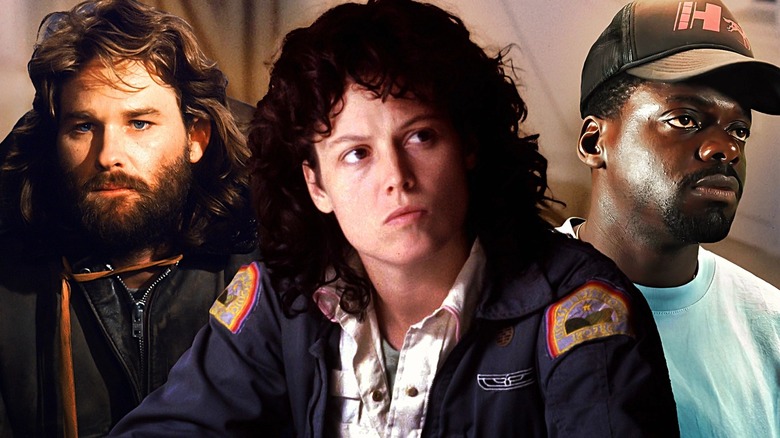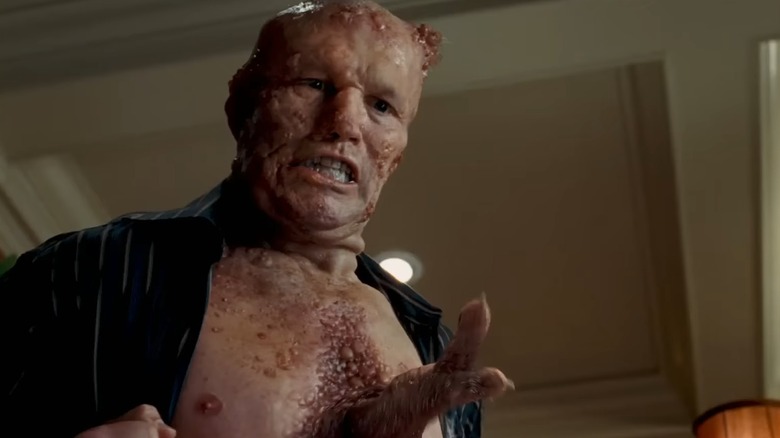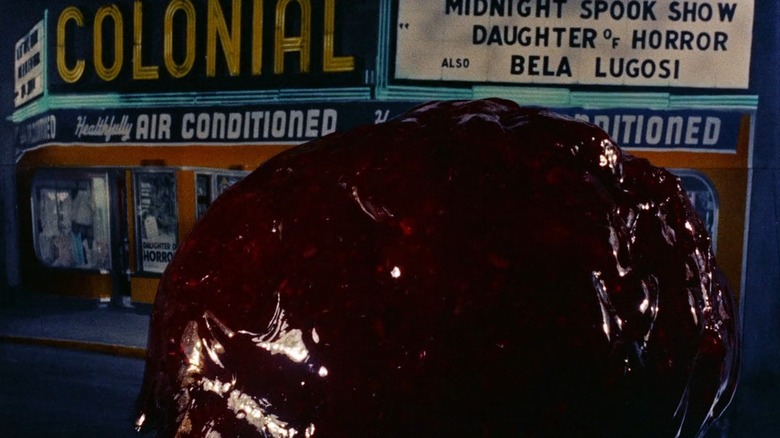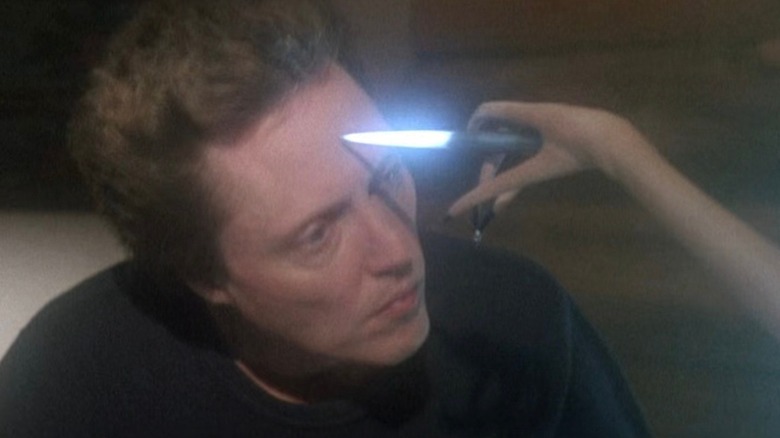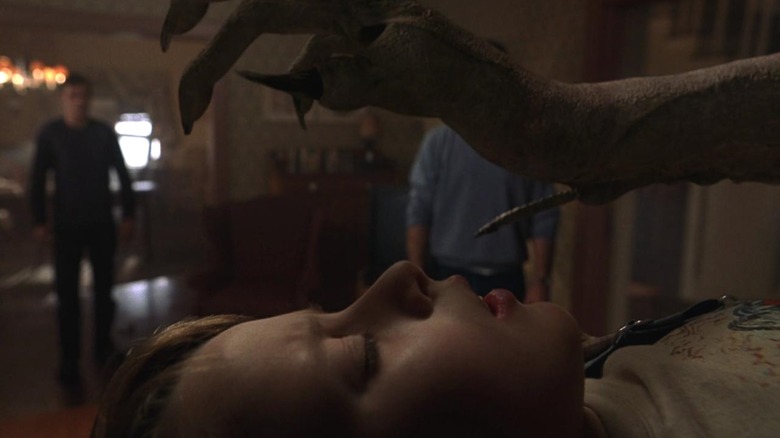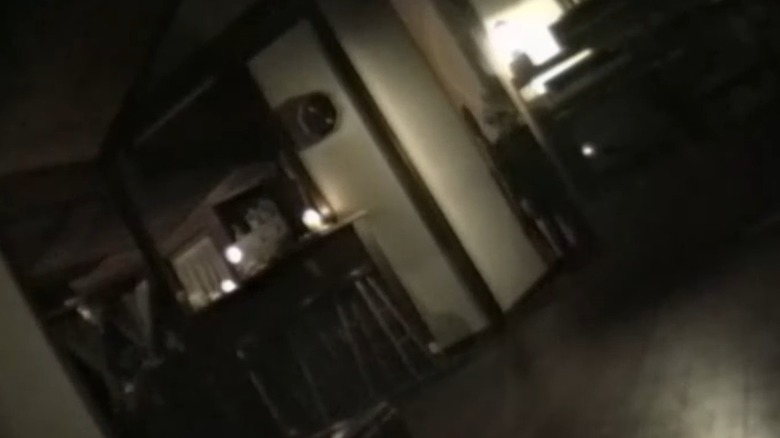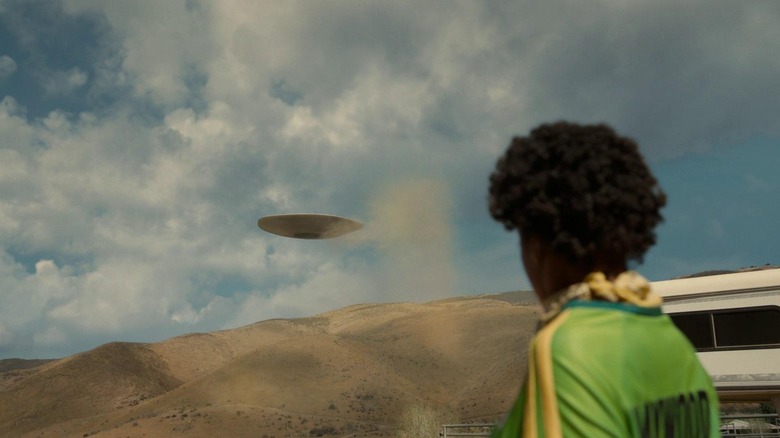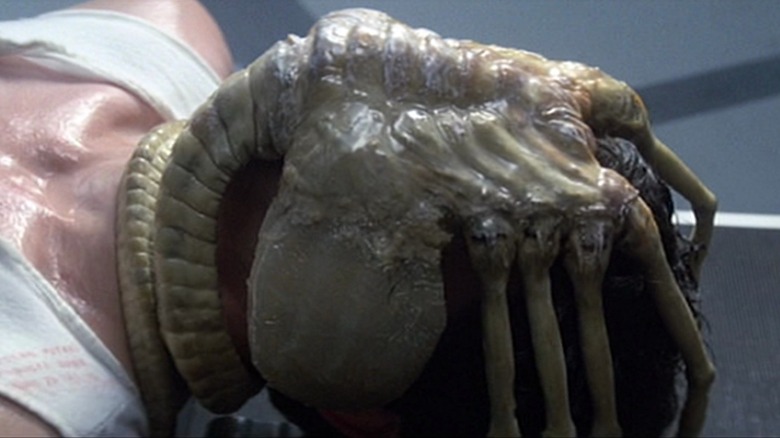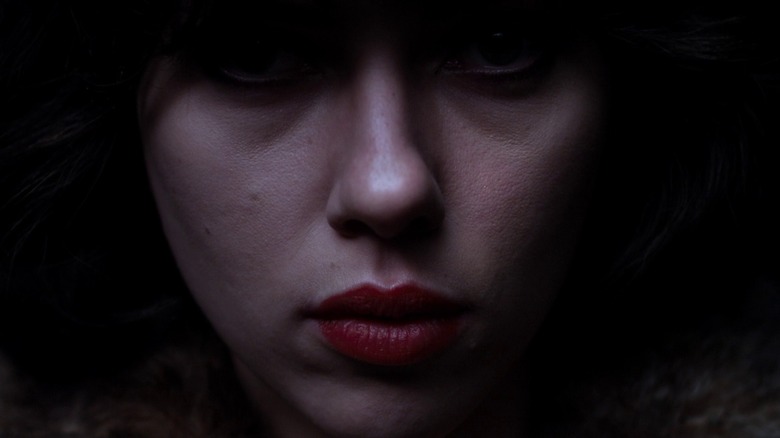The 10 Best Horror Movies About Aliens
One of the very first narrative films, Georges Méliès's "A Trip to the Moon," is about aliens. Sure, everyone remembers that shot of a rocket ship crashing into the eye of the man in the moon, but as the narrative unfurls, the astronauts meet a group of people who live up there. It's not scary, exactly, but there are chase scenes, and in the end, the astronauts bring one of the Selenites back down to Earth with them. Cinema has been obsessed with aliens ever since.
Of course, aliens aren't just the stuff of science fiction. They can also be found throughout the horror genre. After all, there are a lot of ways to make aliens scary. What does an otherworldly visitor look like? Is it scarier if it's something unfamiliar and hideous, or if it looks uncannily like we do? If and when the aliens visit, will they be desperate for our resources? Will we be afraid of them? Even worse, will they be afraid of us? Scientists debate all of the above, with astrobiologist David Grinspoon telling NBC News that it might be a bad idea to try to contact extraterrestrial life. "If you live in a jungle that might be full of hungry lions," he posited, "do you jump down from your tree and go, 'Yoo-hoo?'"
Horror films, then, provides a space (often literally) for us to confront these questions. Here are the 10 best horror movies about aliens.
Slither (2006)
James Gunn's debut film "Slither" is a horror-comedy that wears its influences on its sleeve. There are in-jokes for horror fans all over the movie, most of which are visible on various signs around town. From the R.J. MacReady Auctioneers & Funeral Home (named for Kurt Russell's character in "The Thing"), to Max Renn's Guns & Ammo (named for James Woods in "Videodrome"), to the Earl Bassett Community School (a nod to Fred Ward's character from "Tremors"), it's clear that Gunn wants you to know he's a fan of the genre. He lifts various shots, too, including recreating the swooping, slithering shot through the forest from "The Evil Dead."
That's all besides the point though, because "Slither" is great on its own without all those connections. It's a classic story of a small town visited by a monster from the skies, one that drops down to Earth on a comically small meteorite. Grant (Michael Rooker) finds it in the woods, and before long, he's been possessed by a hive-mind creature with a desperate hunger for flesh. As his body mutates, the alien invasion escalates until the town is overrun with evil little slugs, tiny creatures that force their way down your throat until you become part of the insatiable whole. T
hanks to a number of practical effects that push "Slither's" R rating to the limit, it holds up wonderfully. It's a gleeful, gross-out shocker that uses its aliens to their full grotesque potential.
The Blob (1958)
For some reason, some horror fans refuse to recognize that the genre is inherently political. We've started to acknowledge it more often in recent years, thanks to the work of filmmakers like Jordan Peele. Then there's "The Purge" series, which is one of the most overtly political horror franchises in history.
It's not a new thing, though. Horror having a political edge goes back decades. Case in point: "The Blob," a film from 1958 about an alien that crash-lands outside a small, wholesome all-American town. As the blob consumes anything and everything in its path, it threatens to swallow up the entire population. It's red, it's amorphous, and it's hard to define, and all we know is that you should be very, very scared of it. Did we mention it's the 1950s? Are we getting it? It's "communism," silly!
Sure, you can read "The Blob" as simply a fun, entertaining alien invasion film where a definitely-too-old Steve McQueen plays a teenager. But check out that scene where the blob invades the local movie theater. As a room full of American teenagers watch a horror movie on the screen, the blob grows larger and larger, ultimately forcing everyone out into the streets to spread panic. It's a clear representation of the way Americans were terrified of the populace being propagandized into communism, terrified of the Red Menace that was said to have infected Hollywood. Beware of the blob, and beware of anyone who tells you horror isn't political.
Communion (1989)
In "Communion," Christopher Walken plays real-life UFO enthusiast Whitley Strieber. He's a family man, a guy who loves to make his kid laugh. After a family trip to a cabin in the woods, however, everything changes. Everyone has the same dream involving lights at night, and small figures in their bedrooms. The odd event gnaws at Whitley, and he gradually becomes convinced that he was abducted by extraterrestrials. The knowledge eats him alive. He becomes wracked with shame surrounding a certain type of probe, and "Communion" becomes a drama about a family whose patriarch is losing his mind. ... Or is he being studied by beings from above?
This is an odd one. It's a film where scenes seem to flow into one another like the raw material of a nightmare, conversations ebbing and receding as the film cuts ahead through time. Whitley undergoes therapy to bring back his repressed memories, and when the film gets around to showing scenes of an alien abduction, watching "Communion" feels like looking at a surrealist painting. There are elements you'll recognize from a thousand other alien stories — little grey men with big eyes, that kind of thing — but it all feels put together wrong, so idiosyncratic and odd that it becomes horrific. On one hand, it feels like a metaphor for sexual assault, which can be a tricky subject for male survivors. On the other hand, the real Whitley Strieber insists it all really happened. Which one's scarier?
Signs (2002)
In M. Night Shyamalan's "Signs," Mel Gibson plays Graham Hess, a reverend who's lost his faith. After his wife dies, Graham is left to raise their kids (Abigail Breslin and Rory Culkin) on his own, and he's only got his brother Merrill (Joaquin Phoenix) for help. One day, out on the family farm, a mysterious symbol appears in the cornfield. Graham's family isn't the only one that's been visited, as crop circles crop up all around the world, and before anyone has time to react, ships hover above major cities. We are not alone.
"Signs" hit hard in 2002, mere months after the world watched what felt like a sign of the end times on television. News broadcasts were a major driver of the panic of 9/11, and the characters spend much of "Signs" watching television, too. It's a movie about aliens, yes, but it's also a movie about the helpless feeling that comes from watching a major, world-shifting news story play out on TV. How can you raise your kids in a world that might fall apart any time you press the remote? How can you promise your kids safety, if the danger comes from the skies?
There are lots of ideas stuffed into "Signs," from the religious allegory to the specifics of alien biology. Still, there's nothing like that climax — as all the various threads get pulled together in one shocking sequence, it's hard not to be overwhelmed. There's no one quite like Shyamalan.
The McPherson Tape (1989)
In 1999, "The Blair Witch Project" revolutionized the horror scene, proving that you didn't need a big budget to make something memorable. Now that home video cameras were popular and had become relatively cheap, anyone could make a horror movie if only they had the right idea. "The Blair Witch Project" wasn't the first to do it, however. A decade earlier, "The McPherson Tape" found the found-footage concept first.
Writer/director/star Dean Alioto made "The McPherson Tape" — also known in some home video releases as "UFO Abduction" — and claimed that it showed real footage of a real event. The movie takes the form of a home-video tape that initially chronicles someone's birthday party. But as the night wears on, strange lights and sounds outside signal the arrival of something odd. The party guests begin to succumb to paranoia and fear, certain that there's something in the house with them.
Clocking in at little more than an hour long, "The McPherson Tape" is probably the slightest movie on this list. Still, it's quite effective, especially because of the amateur-esque quality of the videography. It's fun to let yourself believe that you're watching real footage of something unexplainable. After all, in the decades since this film premiered, there are countless shows on television that purport to show evidence of the paranormal. This film is a touchstone in the subgenre, and any fan of alien horror should check it out to see where so many tropes came from.
Invasion of the Body Snatchers (1978)
Even if you've never seen "Invasion of the Body Snatchers," you've likely seen a bunch of movies inspired by it. The 1978 remake of the 1956 original improves on the concept of "pod people," trading on the deeply-unsettling idea that people you love have been replaced by lookalikes. The duplicates grow on mysterious plants all around the city; when they wake up, the original person goes away.
"Invasion of the Body Snatchers" stars Donald Sutherland as Matthew Bennell, a health inspector. Alongside Brooke Adams as Elizabeth Driscoll, Jeff Goldblum as Jack Bellicec, and Leonard Nimoy as Dr. Kibner, the film is about Matthew's escalating panic as he realizes the people around him are being subsumed into this alien entity. He attempts to alert every authority he can think of, but ultimately the group are left to their own devices as they confront the fact that humanity is rapidly losing the war.
The film is set in San Francisco, a fitting place for such a story. After all, they'd very recently been overrun with "flower children" – more commonly known as hippies. San Francisco was the place where, less than a decade earlier, Charles Manson first gathered his Family, and it was also the home base of Jim Jones's cult, who killed themselves at Jonestown weeks before the film's release. In other words, this was a city deeply afraid of conformity and submission, and "Invasion of the Body Snatchers" makes it look more horrific than ever.
The Thing (1982)
No overview of the best alien-based horror films would be complete without a mention of "The Thing." John Carpenter's 1982 film is technically a remake of Howard Hawks's "The Thing From Another World," but Carpenter's is the definitive telling of this story. Set on a remote base in Antarctica, "The Thing" is about a group of scientists who gradually realize that there's an alien entity among them that's come in from the cold. It's able to shapeshift, taking on other forms to pass undetected on the base ... until it makes itself known, to horrifying results.
Like several movies on this list, "The Thing" plays on our fear that someone we know and love might actually have been replaced by some other unknowable, horrible thing. It's all about making the familiar into something grotesque, and boy, does this movie get grotesque. "The Thing" features some iconically great practical effects, turning some of the cast into misshapen, unspeakable monsters.
"The Thing" doesn't just shock; it's chilling, too. The movie plays its cards so close to its chest that fans still debate whether MacReady or Childs is the thing at the end of the movie, and it's fun to realize that maybe the movie can't actually be "solved" as such. It's a film that wants us to wonder, to live in that uncertainty, with knowledge that there might be things in this universe that don't behave according to our own understanding of reality. It's an upsetting idea.
Nope (2022)
Jordan Peele's 2022 masterpiece "Nope" is one of the most visually spectacular alien horror movies ever made. It's about O.J. (Daniel Kaluuya) and Emerald (Keke Palmer), two siblings whose family raises horses for the entertainment industry. They're connected to a long history of Black people in entertainment, one that stretches all the way back to the very first images that were made to move. The family business is in trouble, however, until they realize there's something in the hills. Something big. Massive, really. Something that can fly. Something that hides in the clouds. Something that's very, very hungry ...
"Nope" is a movie about spectacle, about the American drive to turn images of death and destruction into something entertaining. The siblings hope that they can capture proof they've been visited by an alien entity, hoping their one great shot will turn their financial fortunes around. Soon, however, it becomes clear that it might not be the best idea to tempt fate with something so inexplicable.
There are a few great horror sequences in "Nope," but the most memorable involves the alien sucking up crowds of people at a nearby amusement park. Inside the alien's big, billowy body, they encounter a cacophonous nightmare that feels wholly original, wholly unique to this movie. Aliens have been done a thousand different ways, but Peele managed to make something that's idiosyncratic enough to earn its place in horror history.
Alien (1979)
For my money, give or take some ill-advised outings where the Xenomorphs were made to fight the Predators, there are no bad "Alien" movies. They all offer different things, but they're all a ton of fun and they're all plenty intense. For more, check out our ranking of every alien in the "Alien" movies, ranked by how creepy they are.
Ridley Scott's original "Alien," though, remains the best film of the bunch. The 1979 movie is a perfect blend of sci-fi and horror, essentially transposing a familiar haunted-house tale onto a spaceship. "Alien" is about the crew of the Nostromo, a working-class spaceship that picks up a distress signal, and before long, they've accidentally invited a deadly species of extraterrestrial aboard the ship. Instead of things going bump in the night, things clank mechanically as a gigantic alien creature climbs through the vents over your head.
As the crew get picked off one by one, Sigourney Weaver's character Ripley emerges as the film's protagonist. She's a badass Final Girl for the ages, the kind of character you're willing to follow into danger because you're confident in her ability to fight back. The film's third act is a howling maelstrom of alien horror that's as effective today as it ever was; as the ship's alarm wails incessantly and the creature rampages through the halls of the spaceship, Ripley makes a desperate attempt at escape. She even finds time to save the cat Jonesy.
Under the Skin (2013)
Jonathan Glazer's 2013 film "Under the Skin" (which took a decade to make) is one of the most unusual alien horror films ever made. It's a slow, quiet movie about an impossibly-beautiful creature (Scarlett Johansson) that prowls the streets of Glasgow looking for victims. This mostly means driving around in her van, watching the men that pass her by until one catches her eye. After she seduces the men back to her lair, they find themselves in a chilling situation, unable to resist as they sink down into a formless black void.
Despite some mild body horror, this isn't really a film that will scare you, per se. Instead, this is the kind of movie that worms its way under your skin (sorry), draping you in its rhythms until you feel like you, too are floating in a void, unable to figure out which way is up.
This isn't just a film about aliens on a plot level, as it also feels alien on a formal level. As the film slips into the woman's perspective, it genuinely feels like you're seeing humanity through alien eyes, which is an incredibly destabilizing feeling. At the same time, extreme closeups render the face of ScarJo — firmly a movie star by that point — something alien and strange. She keeps her expression almost impossibly blank throughout much of the film, merely observing, and it's downright upsetting in the best way possible.
